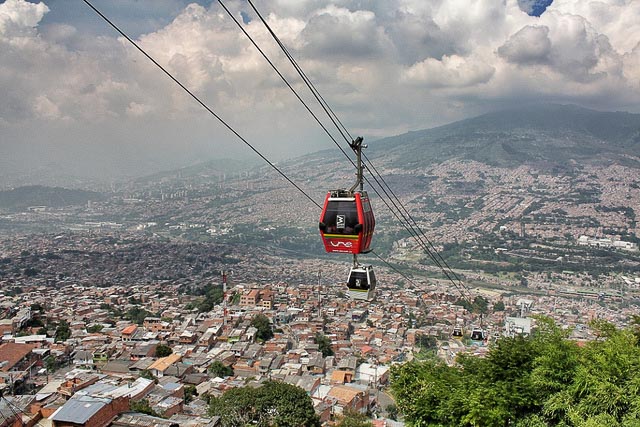In a report published earlier this fall, the World Economic Forum outlines its view of the the top 10 urban innovations happening around the world right now.
The Switzerland-based nonprofit is best known for organizing its annual event in Davos, which draws scores of political, intellectual, and business elites.
In its report, WEF seeks to answer the simple question: what will the cities of tomorrow be like? It highlights 10 innovations happening right now that may offer clues.
The list is included below, but the details of each innovation are available in the World Economic Forum's full report.
1. (Digitally) Re-Programmable Space
With the urban population projected to grow from 4 billion to 7 billion over the next 30 years, it's critical that cities use their space efficiently. The WEF touts Vancouver, Glasgow, and New York for their efforts to promote density and smart use of urban space. How far can cities take that trend? It may sound like sci-fi, but WEF envisions a world where "buildings themselves will also be digitally programmable and able to instantly shift use between a theatre, gymnasium, social centre or night club, further minimizing the overall urban footprint."
2. Waternet: An Internet of Pipes
If demand for freshwater outpaces supply -- as some projections suggest -- we're in big trouble. A new generation of water management tools that rely on technology to monitor operations could be critical to managing the water network. For now, sensors are being used to keep tabs on pipe blockages and weak points that result in waste. But in the future, sensors in sewers could allow scientists to track bacteria and viruses to help get early detection of disease outbreaks.
3. Adopt a Tree through Your Social Network
While walls and levees have been the preferred way to ensure urban resilience against rising sea levels, planting trees could also be helpful. Studies suggest increasing a city's "green" area by 10 percent can help mitigate the effects of rising temperatures. WEF touts Melbourne, which allows citizens to get in on the action by "adopting," naming, and tracking any of its 70,000 urban trees
4. Augmented Humans: The Next Generation of Mobility
A growing number of cities are placing an emphasis of bicycle transportation. WEF touts the economic returns on investments in things like bike lanes and bike-sharing. It's also optimistic about greater adoption of the Copenhagen Wheel, which attaches to bikes and makes it easier to cycle by capturing and repurposing pedal power.
5. Co-Co-Co: Co-generating, Co-heating, Co-cooling
Population growth and industrialization will likely contribute to more carbon emissions. Cogeneration technology, however, can capture heat produced as a byproduct of electricity generation and use it to for other purposes, like heating and cooling buildings. Taking it one step further, carbon capture technology grabs carbon dioxide created during the process of producing electricity and uses it for industrial purposes.
6. The Sharing City: Unleashing Spare Capacity
Airbnb, along with carshare and carpool services, are making it easier to help eliminate waste by putting otherwise unused resources to use. WEF builds on that idea with the concept of "co-location." For example, a school could be co-located with a sports park to enable shared use of its equipment and facilities. Child health services could be co-located at schools to ensure they're more accessible.
7. Mobility-on-Demand
The World Health Organization attributes 1 million deaths per year to outdoor air pollution, largely caused by traffic. WEF predicts that on-demand vehicles could one day replace public transit. Self-driving vehicles promise to blur "the distinction between private and public modes of transportation" if they can be used by other people during the day rather than sit for hours in a parking lot.
8. Medellin Revisited: Infrastructure for Social Integration
Once considered a dangerous place, Medellin, Colombia is today the darling of urbanists thanks to initiatives launched in the mid-2000s. For example, its elevated cable cars connect low-income residents with wealthier areas. Thanks to Medellin, cities have learned that "using architecture and urbanism as a tool for social development can bring surprising results in physical, functional and behavioral changes," WEF writes.
9. Smart Array: Intelligent Street Poles as a Platform for Urban Sensing
WEF projects that in the coming year, 4 billion street lights worldwide will be converted to LED, which are less hazardous and last longer than the status quo. Those lights can also include new sensing technologies that collect data on weather, pollution, and traffic, among other things. WEF proposes that those sensors (and the data they obtain) could transform street lights into revenue-generating assets for municipalities. But, it cautions, implementation will have to be done carefully, and "transparency is key when it comes to public surveillance."
10. Urban Farming: Vertical Vegetables
A huge portion of the produce we grow goes wasted every day. WEF says we can reduce waste by moving farms closer to the cities and growing produce on rooftops and along walls using soil-less, hydroponic systems. It also highlights a company that turns shipping containers into fully functional farms that can be managed via smart phone.

